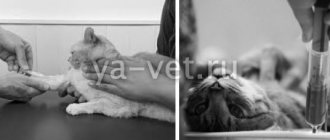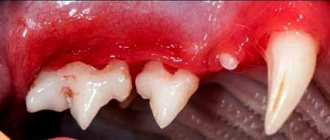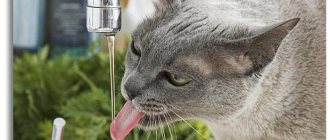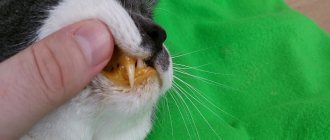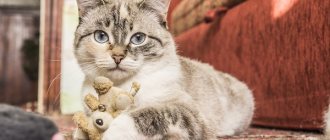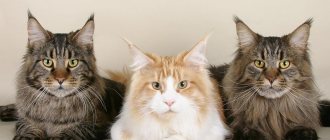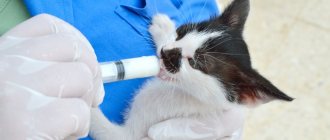What is blood type?
Blood group is what allows individuals (both humans and animals) to be grouped into certain biological groups. These are immunogenetic characteristics that determine the hereditary combination of cells - red blood cells. It does not change during the life of a person or animal. Therefore, to the question: “Do cats and dogs have a blood type?” you can confidently answer “Yes, there is.”
Group characteristics are formed in the prenatal period. This occurs under the influence of allelic genes that are responsible for the characteristics of antigens in red blood cells.
Blood in a cat's stool: treatment
Having found out why the cat has bloody stool, the specialist draws up a treatment plan. If there are foreign objects in the esophagus or neoplasms are detected, regardless of their nature, only surgery under general anesthesia will help.
If the cause of bloody stools is poisoning, then an antidote with a high content of vitamin K is administered. Additionally, droppers and gastric lavage are prescribed. Maintenance therapy and iron supplements are selected.
For infections, symptomatic treatment is prescribed, and it is important to start it in the first 72 hours to prevent the possibility of complications. The specialist will leave the pet under observation and select medications.
How to determine the blood type of animals?
Blood group determination in cats and other animals is carried out using special reagents. Specific sera are used that contain one labeled antibody for each specific antigen.
The determination procedure itself involves mixing blood with serum. When agglutination with serum does not occur, this will mean that the material belongs precisely to the group for which antibodies were contained in the serum.
Various reactions are used to determine blood type in different animals. For example, in birds and pigs the agglutination reaction is taken as a basis, but to determine the group in cattle, the reaction of conglutination and hemolysis is assessed.
Blood incompatibility during transfusion
Unfortunately, any animal may require an emergency transfusion due to injury or illness. Before starting the procedure, the doctor will definitely conduct the necessary tests. But if you know your pet’s blood type, this will help you find a donor faster.
Hemotransfusion (blood transfusion) may be urgently needed in the following cases:
- serious injury with large loss of blood;
- prolonged, although not severe, bleeding;
- difficult childbirth;
- extensive surgery.
The procedure is also indicated for anemia, decreased immune status, blood clotting disorders, as well as chronic inflammatory processes and very severe poisoning.
Important! In the event of a blood transfusion of an incompatible group, antibodies will attack foreign cells of the donor blood, which in most cases leads to death.
The meaning of blood group for animals
Blood groups in dogs and cats, and especially in farm animals, are of great importance in their breeding. One type of animal can have hundreds of different variants.
Assigning an animal to one group or another is important for blood transfusion or organ and tissue transplantation. In the practice of animal breeding, genetic blood traits are used to trace the ancestry and pedigree, as well as the genetic structures of entire groups of animals. Taking into account group characteristics makes it possible to breed animals with improved performance.
When do you need a veterinarian diagnosis?
If you notice blood in your cat's stool for the first time, switch your family pet to wet food and observe for a day or two. You can cook your own cereals, vegetables, fish, or buy ready-to-serve packets from the store. Switching to a wet diet and drinking enough fluids will usually solve the problem of blood in your cat's stool.
If there is no improvement, and the cat’s health is getting worse, you need to seek help from a veterinarian. You shouldn’t experiment with home remedies, follow only the advice of “experienced” forum members and hope that everything will go away on its own.
The doctor evaluates a combination of factors: the animal’s age, dietary habits, and what diseases the pet has already suffered. The veterinarian will recommend a detailed examination of feces, blood and urine, an ultrasound of the abdominal organs to understand which organ is affected, identify allergens, and, if necessary, get rid of parasites.
How many blood types do animals have?
We have figured out the presence of the latter in animals. Now the question may arise: “How many blood types do cats and other animals have?”
For example, 12 blood groups have been identified in cattle, 15 in pigs, 14 in chickens, and 7 in horses and sheep. As for our pets, 8 groups have been found in dogs, and 3 in cats.
Such a large number of groups in animals is explained by the fact that their blood contains a large number of antigens that have not yet been fully studied. As a result, new groups arise among one species of animal.
Interesting fact! The blood of animals and humans is absolutely not suitable for transfusions to each other. Even a chimpanzee or ape that seems so close to us is also not suitable. And all this despite the fact that the first experience of blood transfusion was from sheep to humans, even before the discovery of the latter’s blood groups. By the way, it ended successfully.
Prevention
To prevent the formation of blood in your cat’s feces, it is enough to follow simple rules: provide the correct diet, keep chemicals, poisons and rodent poisons away, and also maintain your pet’s personal hygiene.
First, don’t feed the cat:
- any food from the “human” table,
- pork,
- tomatoes and eggplants,
- foods with a lot of seasonings,
- cereals.
Everything fatty, salty and fried will only harm your pet. Your cat's momentary joy can lead to serious and undesirable consequences in the future, including the appearance of blood in her stool.
Secondly, ensure the hygiene of the animal. It is recommended to accustom your cat to washing its paws and brushing its teeth from an early age. Teeth brushing should be done at least 2 times a week, and paws should be washed after each visit to the street.
So, blood in a cat's stool is a deviation from the norm. It is impossible to independently determine the cause of this condition, so you should not hesitate to contact a professional veterinarian in Moscow. Remember that in many cases your pet’s future health depends on your reaction!
"Cat" blood types
Cats, just like people, have 2 antigens: A and B. If humans have 4, then cats have only 3: A, B, AB. Moreover, group AB is the rarest, and group 0 does not exist at all, at least for now.
Considering the above, you need to keep in mind that only cats and female cats need blood transfusions of their groups. This is a significant difference between them and other pets, such as dogs. For them, this process does not require such control and takes place with virtually no risk to life and health.
The other two groups (A and B) are common, with group A being the most numerous.
Research on blood groups in cats began not so long ago as the study of a similar issue in humans. Only in 1953 were they bred by an English scientist, who also studied the patterns of their inheritance.
After this discovery there was a thirty-year break. No one studied this issue, because it began to be considered not so important in veterinary medicine. After we were faced with the sudden death of newborn kittens and hemolysis of their blood (as it turned out later), interest in this issue increased again.
Only in 1981, scientists Auer and Bell experimentally proved the fundamental nature of this issue in blood transfusion of sick animals and the prevention of mortality in newborn kittens.
Since cats do not have the Rh factor, the inheritance of blood types occurs according to the laws of Mendel, who is well known to everyone since school for his experiments in crossing peas.
You can now find out what blood type a cat has in a veterinary or diagnostic laboratory that specializes in this.
Why is it important
In the 50s, English scientists examined the blood of cats and determined the presence of groups and patterns of inheritance. But then, for 30 years, practically no one dealt with this issue; they did not consider it important. And only in the early 80s did zoologists return to research.
Blood is red in color due to blood cells called erythrocytes. In addition to the fact that these blood elements carry oxygen to every cell of the body, they are also responsible for the blood type. The red blood cell carries a protein called an antigen, and the blood plasma contains antibody proteins. They are responsible for the destruction of foreign antigens.
Knowing exactly which group your pet belongs to is important in the following cases:
- if the animal requires a blood transfusion;
- when choosing a partner for breeding.
Veterinarians strongly recommend testing to determine your blood type at an early age. This will save valuable time if your pet suddenly needs emergency medical care.
Breeds and blood types
Through their research, scientists from America and England have proven that the inheritance of certain blood types in cats is influenced by the breed and area where the animal lives.
Group A. Most cats without a breed have it. As for purebred cats, this group is observed in Siamese and Oriental cats, as well as in breeds close to them such as Burmese, Ocicat, etc.
Group B. This group is less common, for example, only 5% of the Maine Coon and Norwegian Forest breeds. But among Abyssinians, Somalia, Scottish Fold, Burmese, Kuril Bobtail and Persian cats, this group is found in 20-25% of animals. The most numerous breeds with this blood type are British cats, exotic shorthairs and rex cats. 30-60% of their representatives have it.
Group AB. It is very rare, so there are no statistical data on this blood type in cats. Breeders try not to mix blood of groups A and B to eliminate the mortality of offspring and preserve the purity of the animal’s pedigree.
Preventing Blood in Your Cat's Urine
We are always looking for ways to prevent conditions such as hematuria in advance. Unfortunately, it is impossible to completely prevent lower urinary tract disease in cats. We know that FLUTD/FIC appears to be more common in cats that have low water intake and are inactive or obese. These factors may partly influence how often your cat urinates. Controlling your weight and exercise and water consumption may provide some benefits in preventing cystitis and FLUTD. Having an enriched environment with clean and accessible litter boxes can also help with this issue. If bladder stones are the cause of blood in the urine, special therapeutic diets may help prevent recurrence. If you suspect that your cat may have blood in its urine, please contact your veterinarian immediately. The sooner you receive a diagnosis and proper treatment, the sooner your cat can return to a healthy, pain-free life.
If you have any questions or concerns, you can always visit or call our veterinarian - this is the best option for ensuring the health and well-being of your pets.
Blood transfusion
As we have already found out, each animal has specific blood, so its transfusion between different types of animals can be destructive.
If a person has about 5 liters of blood in the body, then cats have about 70 ml per kilogram of weight. Thus, a 3-kilogram cat will have approximately 210 ml of this red liquid, but a large cat weighing 6-7 kilograms will have about half a liter (420-490 ml).
Blood transfusion may be required under various circumstances. Basically, if all the points are followed correctly, then this procedure is very successful in preserving the life and health of the pet. However, it is worth keeping in mind the risk of transmission of infection.
If the blood used is not fresh, that is, not the one that has already disappeared, but the one that has been cooled and stored, then problems in the cat’s immune system are possible. You may experience a slight fever or nausea during the transfusion or after the procedure.
An acute hemolytic reaction is possible, which can be fatal. The presence of any reaction should be reported to a veterinarian. It is also necessary to inform him if the cat has had a transfusion in the past.
What is vomiting blood?
Hematemesis (“bloody” vomiting) is a term that is used for both animals and humans. This is a reflex reaction in the form of evacuation of the contents of the stomach in response to the influence of an irritant (along a reflex arc) as a result of sharp involuntary contractions of the abdominal muscles.
A cat vomits before vomiting only in a pathological condition, and with normal physiological vomiting (regurgitation), nausea does not occur. At such moments, saliva is released abundantly, the animal becomes restless and begins to lick its lips frequently.
Important! Vomiting in cats is not an independent disease. It is only a sign of pathology, and the presence of blood in the vomit indicates a serious threat to the health and life of the pet.
Incompatibility of group characteristics
The compatibility of blood groups in cats is important for their life and health. If incompatibility is observed, then disastrous consequences are possible, which most often lead to the death of the animal. It can appear in two cases: at birth or during a transfusion.
Incompatibility between the blood of a cat and her kitten develops according to the type of Rh conflict in humans. When a cat has group B, and a male cat has group A, and the kitten inherits the father’s group, that is, A, or has group AB, then a conflict develops. In the womb, the kittens are not in danger; they can be born healthy and without complications. But after a while you may notice the following:
- sudden death of a seemingly absolutely healthy kitten;
- poor appetite, dark urine, lethargy for the first three days, then death;
- the kittens look absolutely healthy, feed well on mother's milk and develop, but after 1-2 weeks the tip of their tail dies off.
All this happens because with mother's milk they consume mother's antibodies, which are harmful to their blood. In this case, in humans, it is recommended to stop breastfeeding and switch to artificial feeding. In veterinary medicine, this can also be applied, but the problem is that in animals it cannot be determined in advance and the necessary measures taken immediately after the birth of a kitten.
Of course, there are times when incompatible kittens survive and remain healthy. But for this, the kitten must have such individual characteristics that will prevent the absorption of maternal antibodies by the intestinal walls.
There is another option to save the litter. Immediately after birth, separate all kittens from their mother for 2-3 days, so that the permeability of the intestinal walls decreases enough to prevent maternal antibodies from leaking into the kitten’s blood. The cat can then safely feed her kittens on her own. But this method can significantly deteriorate the health of the litter.
BLOOD TYPES IN HUMANS Blood groups in humans are combined into the ABO system: group A; group B; group AB; group O (zero group, i.e. neither group A nor group B). The formation of a particular blood group is controlled by one gene, which has three allelic forms: IA, IB, i. Individuals with genotype IA IA have blood group A (it has been noted that this group is quite rare among residents of Western Europe). Genotype IB IB corresponds to blood group B. Genotype IA IB is characteristic of blood group AB. Individuals with genotype ii have blood type O. Those with blood type A have the A antigen; blood group B has a B antigen; Blood group AB is characterized by the presence of two antigens - A and B; and individuals with blood type O have no antigens at all. Type A blood produces b-antibodies that “work” against red blood cells with antigen B. The blood of a person with group B produces a-antibodies directed against the A-antigen. Type AB blood contains both a-antibodies and b-antibodies, while blood group O has no antibodies at all. When giving blood transfusions, it is very important to know the blood groups of the donor and recipient. If they match, and their Rh systems also match, then the transfusion does not cause complications in the recipient. People with blood type AB can accept donor blood of group A and group B. And the blood of a donor with type O can be administered to a person with any blood group, since type O does not produce antibodies and is a universal donor blood. A characteristic feature of group AB blood is the low concentration of antibodies in it. Therefore, the influx of blood from other groups cannot cause a rejection reaction dangerous to the health of the host, and people with blood group AB are called universal recipients. In addition to the ABO blood group system, there is an equally important RH SYSTEM for determining the compatibility of human blood, which is used to determine the presence in the blood of a specific D-antigen or Rh factor (from the name of a small monkey from the genus of macaques). Based on the presence or absence of the Rh factor, Rh-positive individuals (about 85% of people) and Rh-negative individuals (about 15% of people) are distinguished. The D gene has two alleles: D and d. The combination of DD or Dd in the genotype gives rise to the D antigen, the presence of which in the blood is characteristic of Rh-positive individuals. Unlike the blood group system (ABO), the Rh system does not have natural antigens. Antibodies begin to form only after contact with the human blood defense system. For example, a Rh conflict may occur between mother and child during pregnancy. If the mother is Rh negative (there is no D antigen) and the fetus is positive (there is D antigen), then after the baby’s blood cells enter the maternal blood through the placenta, the latter will begin to produce antibodies against the D antigen. These antibodies pass through the placenta will “return” to the child and cause the destruction of his blood red blood cells. As a rule, the rejection reaction occurs in the last period of pregnancy or immediately after the birth of the child. And if during the first pregnancy the conflict between the Rh systems of the mother and child, as a rule, is not too dangerous for the health of the baby, then in subsequent pregnancies it can cause severe immune complications (hemolytic disease of the newborn, etc.). To prevent such complications, modern doctors inject the mother with anti-Rhesus gamma globulin, which suppresses the formation of antibodies in her blood. BLOOD TYPES IN CATS
Cat blood group system. Cats have their own blood group system, knowledge of which is important when receiving blood transfusions and overcoming some of the difficulties during breeding. This system is not related to the ABO human blood group system already described above, but is called AB. The most common blood is type A. The number of animals with group B varies depending on the breed and habitat, ranging from 3% to 50% (Giger et al., 1991). It is extremely rare to find individuals with blood group AB (such cats are naturally universal recipients). Blood type O, known among humans, does not exist in cats, so there are no universal donors among the representatives of their tribe. Consequences of blood group incompatibility in cats. Before a blood transfusion, it is essential to have blood tests done on the donor cat and the recipient cat. Type A blood cannot be transfused into cats with blood type B. If the donor blood does not match the recipient's blood type and contains foreign antigens, then the antibodies in the recipient's blood plasma will cause the red blood cells in the donor blood to clump and destroy. The feline blood group (AB) system also has implications for reproductive processes. But unlike the human Rh system, antibodies do not penetrate to the fetus through the placenta of the mother cat. This occurs when the kitten receives the first portions of maternal colostrum. And if a cat has blood type B, and kittens have type A, then the threat to the health of kittens is especially great. Studies have shown that the blood of cats with type B contains more a-antibodies than b-antibodies in the blood of group A. Therefore, the colostrum of B-cats is saturated with a dangerously high dose of A-antigen for kittens. The urine of such kittens takes on a reddish-brown tint. Death can occur very quickly and is caused by the process of destruction (sticking together) of red blood cells. This process is called Feline Isoerytrolysis (FNI) - feline isohemolysis. Blood group studies in cats. Genetic studies have shown that the process of formation of blood groups in cats is controlled by one gene, which has two allelic forms. This gene does not yet have its own name, so we will conventionally designate its alleles A and B. Allele A is dominant in relation to allele B. Therefore, the combination of AA and AB belongs to blood group A, and the combination of BB produces blood of group B. A rare group in cats AB is apparently formed as a result of duplication of genetic material, so the genotypes of the AB group must be either AA/BB or AB/BB. As mentioned above, the so-called O blood group, which lacks A and B antigens and does not produce the corresponding antibodies, has not yet been discovered in cats. Typically, cats have type A blood. It is currently quite difficult to draw specific conclusions about the dependence of the appearance of the rather rare B group on breed or geographical factors, since only a few statistical studies have been conducted on a small group of animals (from 300 to 3000 individuals). The problem described above of mother cats with blood type B and offspring with type A becomes more complicated if the father of such a litter is a cat with blood type A. If the cat’s blood genotype is AA, then all kittens have blood type A with genotype AB. Such a litter has little chance of survival. If a cat has an AB blood genotype, then according to statistics, only half of the litter can inherit blood type A (AB genotype), the remaining kittens will receive type B blood (BB genotype), similar to their mother’s. They will be able to avoid the risk of FNI. Incompatibility of blood groups of cats and kittens. If a breeder knows what blood types his sires have, he can avoid the negative consequences of incompatibility between the blood types of a cat and its offspring. To do this, during the first 72 hours of the kittens’ life, they need to be separated from their mother and fed artificially. Thus, the kittens will “miss” the portion of colostrum with the maximum concentration of antigens. However, it must be taken into account that in this case their overall immunity will be reduced due to the fact that the intestinal walls of babies can allow maternal antibodies to pass through only during the first 48-72 hours of life. To improve the vital status of such a litter, modern immunomodulators and complex vitamin preparations can be used. Unfortunately, research on the frequency of blood types A and B in cats is still insufficient to provide any specific conclusions or recommendations. But for those who are seriously interested in this issue, we can recommend paying attention to the works, a list of which is published at the end of this article. Advice for breeders. If a breeder wants to get healthy offspring, it would be wisest to avoid breeding cats with blood type B and cats with blood type A, for which, of course, you need to know the blood types of the main breeders and their offspring. Cats with blood group A can be bred to any male cat. However, this will lead to the identification of a kind of “island” of animals with blood group B, since kittens with the same B-group will be born from cats and female cats with blood group B, and cats from these litters can only get “island residents” (i.e. i.e. only cats with type B blood). I think that a situation in which a breeder limits his work to one, and rare, blood type is not very successful for the implementation of breeding programs. I would formulate my thought as follows: rare will always remain rare. And it is better not to become dependent on animals that are exceptional in some respects. It may turn out, of course, that your favorite cat breed is predominantly characterized by the B blood group. Well, you will have to learn to work in such conditions. If you have tested the blood of your animals and it turns out that a cat with blood type B is expecting kittens from a cat with blood type A, it is necessary to determine the kittens' blood types at birth (it is best to take blood for analysis from the umbilical cord). If kittens with type A blood are identified, they need to be fed separately according to the scheme described in the previous part of this article. And even better, in this case, have a female cat with type A blood “in reserve”, which will help you feed such kittens. GLOSSARY OF TERMS
Agglutinin is a specific antibody contained in blood plasma that causes gluing and precipitation of a suspension of bacteria, red blood cells and other blood cells carrying antigens. This reaction is called agglutination and is used to determine blood groups, identify pathogens of infectious diseases, etc. Agglutinogen is an antigen that stimulates the formation of specific antibodies - agglutinins. Antibody is a globular protein (immunoglobulin) found in the blood plasma of humans and warm-blooded animals. Formed after foreign organic substances enter the blood or lymph. It has the ability to specifically bind to bacteria and prevent their proliferation, as well as neutralize toxins released by microorganisms. An antigen is a complex organic substance of biological origin (toxins, enzymes, proteins). Once in the body, they cause the formation of highly specific protective substances - antibodies. Due to the specificity of proteins for each individual, proteins from one animal are antigens for another animal of the same species. Colostrum is a secretion of the mammary gland, which is produced in the last day of pregnancy and in the first 3-4 days after birth. Compared to milk, it contains more proteins, fats and minerals. Essential food for newborns. The Rh factor (Rh) is any group of genetically transmitted agglutinogens that exist in the blood of most individuals (Rh-positive). May cause hemolytic reactions under certain conditions, such as pregnancy and/or blood transfusion in individuals lacking this factor (Rh negative). The author of the article is Anneke L. Leipoldt, a specialist in the field of molecular biology (Denmark). Reprinted from www.rolandus.org
What are the risks of incompatibility?
In addition to the above symptoms of incompatibility, the following options are also possible:
- death of a kitten without visible symptoms of underdevelopment or disease;
- the newborn kitten is very weak and is not able to suck mother’s milk on its own;
- the kitten sucks milk on its own, but less and less each time;
- jaundice in a kitten (yellowishness of the mucous membranes);
- anemia due to blood hemolysis (destruction of red blood cells with further release of hemoglobin into the blood plasma);
- further growth and development while maintaining minimal occurrences of anemia.
Why is my cat bleeding from his eye?
Dacryocystitis
The disease is characterized by inflammation of the lacrimal sac, which can be congenital and diagnosed in kittens, or acquired, developing against the background of other diseases. Most often, dacryocystitis is caused by sinus infections. Due to the inflammatory process, the circulation of tear fluid is disrupted. The mucous membranes swell and the blood vessels located in them can burst, causing bloody discharge from the eyes. Symptoms:
- the appearance of mucopurulent discharge;
- redness of the conjunctiva;
- swelling in the area of the lacrimal sac;
- soreness;
- blurred vision;
- slight increase in temperature.
Traumatic injuries
This symptom is typical for animals that have suffered visual injuries during a fight with their fellow animal.
Bloody discharge in a cat appears as a result of an open injury to the organ of vision during a fight with relatives, or a strong blow to the eye area with a heavy object. The cause of hemorrhage is also the entry of a foreign body - wood or metal specks, glass. A cat may scratch its eye when washing itself. There is a rupture of the eye membranes, displacement of the lens. When the orbit is fractured, the structures of the eye are damaged by bone fragments. The kitten is injured while playing with sharp toys, and damage can also be caused by the cat carelessly washing or restraining the baby. Signs:
- bleeding;
- displacement or prolapse of the eyeball;
- severe pain and shock;
- corneal clouding;
- tears flow profusely;
- swelling of surrounding tissues.
Neoplasms of the lacrimal glands
Bloody tears from the eyes of a cat appear due to phlegmon, when pathogenic microbes enter the orbit or an abscess due to advanced inflammation of the lacrimal gland. Tumors also arise when metastases spread from surrounding foci. Manifestation:
With this disease, the cornea of the organ may become cloudy.
- strong pain;
- temperature increase;
- discharge from the eyes mixed with blood;
- change in organ color;
- impaired motor function of the eyeball;
- swelling of the conjunctiva;
- corneal clouding;
- decreased or lack of appetite;
- blurred vision.
Hyphema (bleeding into the eye chamber)
The pathology develops against the background of injuries, inflammation of the choroid or iris, due to high blood pressure, diabetes, and also as a complication after surgery. Blood accumulates in the anterior chamber of the lower part of the eyeball, so it is visually felt that the cat’s eyes are filled with bloody fluid. Signs:
- pain syndrome;
- increased reaction to light;
- decreased vision;
- intraocular hypertension.
How to prevent blood group incompatibility?
In order to avoid unpleasant consequences, there are several ways to prevent incompatibility between the group characteristics of a cat and a kitten.
- Prevention is better than eliminating consequences. For this purpose, only cats and cats with group B occur. In such a situation, antibodies to the blood of the fetus do not arise.
- Incompatibility occurs only in the case of blood group combinations such as cat B + cat A = AB kittens or cat B + cat AB = AB/B kittens. We must try to avoid such confusion.
- Take measures to save the litter if cat B and cat A were mated. Separate the kittens from their mother immediately after birth for at least a day, and preferably two or three. At this time, feed them yourself every 2 hours.
Blood bank
The clinic where Igor Pasichenko works has a dog blood bank.
“This is the only blood bank in Perm and, probably, in the Urals,” explains the veterinarian. — We have blood plasma, red blood cells. It is not always enough, but we try to always have it. If necessary, plasma is removed from the freezer, where it is stored at −40°C, thawed and can be administered to the patient. The red blood cell mass is also stored in the refrigerator.”
The collected blood is stored in special bags under special conditions. Photo: From personal archive
Previously, in order to have a blood supply, the clinic had to hold donation days, to which city residents were invited with their healthy pets. But, unfortunately, the event was not in great demand: people asked many questions, but did not bring their animals often. Then the veterinary clinic came up with a collaboration with old friends: the nursery of the Ministry of Internal Affairs.
Now every 3-4 weeks, medical examinations of service dogs are carried out in turn. First, the potential donor is fully examined and his condition is assessed. If the animal is healthy and taking blood will not harm it, then it becomes a donor.
“About once a month we replenish the blood bank in this way. Just as before, whole workshops of people went to the blood transfusion station, so it is here. If you call out in the house, then probably no one will come. But in a team it’s organic.”
Article on the topic
For a child - a poodle, for a pensioner - a Pekingese. Veterinarian on how to choose a dog
How is diagnosis carried out in a veterinary clinic?
The veterinarian conducts a full examination, carefully studying the clinical symptoms and general condition of the animal. Using palpation, it determines how tense the abdominal muscles are and whether there are any foreign formations.
In addition, an ultrasound of the abdominal organs, an ECG is performed, blood is taken for general and biochemical analysis, for the presence of pathogens of infectious diseases. Based on the results of the examination and tests, the animal is prescribed the necessary treatment (in some cases, surgical), and recommendations are given to its owners for further care of the pet.
Any frequent or periodic vomiting, especially with blood, means a serious deviation in the cat’s health! The animal experiences dehydration, exhaustion, decreased hemoglobin levels - the animal suffers and fades before our eyes.
Therefore, if you are concerned about the condition of your beloved pet, do not put off visiting a doctor. It is a timely visit to the veterinarian that will help stop the development of the disease and keep your cat as healthy as possible.



